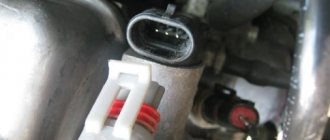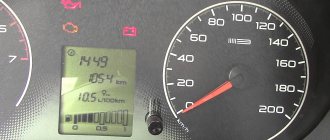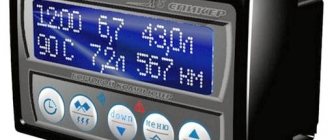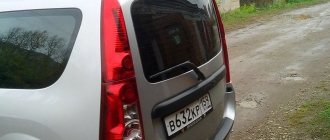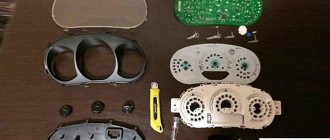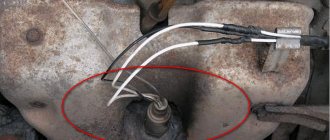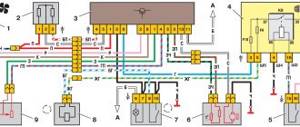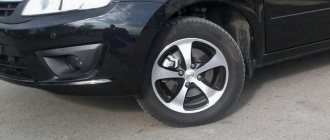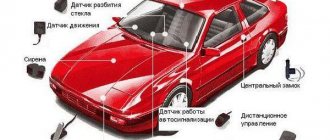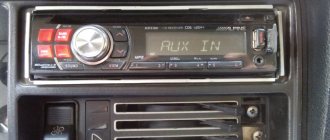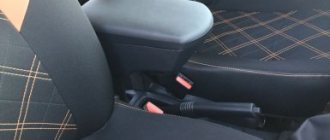An on-board computer is a rather complex mechanism for interaction between electronics and technical components of a car. At the same time, most likely you underestimate its work, especially if you think that all it is capable of is displaying average fuel consumption, remaining mileage after refueling, and the like. In fact, the on-board computer is capable of much more. How does the on-board computer work? Let's figure this out!
Today, the fight for safety in the car is more relevant than ever, and therefore manufacturers are increasing the number of microprocessors. Some of the reasons for this increase in the number of microprocessors are:
- The need for sophisticated exhaust gas control to meet emissions limits and fuel economy standards.
- Advanced yet simplified diagnostic tools.
- Simplifying vehicle production and design.
- Reducing the number of wires in cars.
- New security features.
- Ensuring comfort and ease of machine control.
In this article we will look at how each of these factors influenced the operation of the car’s on-board computer, as well as the individual modules that make up the on-board computer (read as “separate convolutions of the electronic brain”).
Hover over text or over a specific module in the vehicle
What is an electronic control unit (ECU)
When emissions laws were just being passed in various countries, it was still possible to do without microprocessors in the engine. But with the passage of stricter emissions laws, more complex control circuits have become necessary to regulate the quality of the air/fuel mixture so that the catalyst can remove much of the pollution from the exhaust gases.
Engine management is the most intensive computer operation in a car, and the engine control unit (ECU) is the most powerful computer on most cars. The ECU uses closed-loop control, a control circuit that analyzes engine output to control the engine, monitoring engine emissions and fuel economy (as well as many other parameters). By collecting data from dozens of different sensors, the ECU knows everything from the temperature of the coolant to the amount of each substance in the exhaust gases. Using this data, it performs millions of calculations every second, including analyzing values in engine data tables, calculating the results of long equations, deciding the best timing to fire the spark, and determining how long the fuel injector should be open. The ECU does all this to ensure the lowest emissions and best mileage per tank of fuel.
This is what the ECU looks like
In addition, the on-board computer ECU works in conjunction with virtually all sensors and control devices throughout the vehicle.
A modern ECU may contain a 32-bit 100-200 MHz processor. This may not seem that fast compared to the more than 2,000 MHz you probably have in your computer, but remember that the processor in your car is running much less busy code than your home computer. The average ECU code takes up less than 5 megabytes (MB) of memory. By comparison, you're probably working on a laptop with at least 4 gigabytes (GB) of RAM, which is 800 times more than the ECU.
The on-board computer consists of hundreds of components on a multilayer board. Some of the main components in the ECU that support the processor include:
- Analog-to-digital converters. These are devices for reading the output from certain sensors in a car, such as the oxygen sensor. The oxygen sensor output is an analog signal in nature with a voltage typically between 0 and 1.1 volts (V). The processor can only understand digital values, so the analog-to-digital converter changes this voltage into a 10-bit digital signal.
- High level digital outputs. On many modern cars, the ECU controls the spark plugs, opens and closes the fuel injectors, and turns the radiator cooling fan on/off. All of these tasks require digital outputs. A digital output is either on or off (called a boolean type) - there is no other value. For example, a fan control output might provide 12V and 0.5A to the fan relay when it is on and 0V when it is off. The tiny amount of power that the processor can output excites a transistor in the digital output, allowing it to output much more power to turn on the cooling fan relay, which in turn provides even more power to turn the cooling fan.
- Digital-to-analog converters. Sometimes the ECU must provide an analog voltage output to control certain engine components. Since the ECU processor is a digital device, it must have a component that can convert the digital number into an analog voltage.
- Signal cleaners. Sometimes inputs or outputs must be adjusted for readability. For example, an analog-to-digital converter that reads voltage from an oxygen sensor may be designed to read a 0-5 Volt signal, but the oxygen sensor only outputs 0-1.1 Volts. A signal purifier is a circuit that regulates the level of signals coming in and out. For example, if we applied a signal conditioner that multiplied the voltage from the oxygen sensor by 4, then we would get a 0-4.4 volt signal, which would allow the A/D converter to read the voltage more accurately.
- Combining chips. All microcircuits in the car's on-board computer are tightly connected to each other. There are several standards used for their communication, but the dominant one in the car is the CAN (Controller Area Network) standard. This communication standard allows data exchange speeds of up to 500 kilobits per second. This is much faster than older standards. This speed becomes necessary because some data modules on the bus operate hundreds of times per second.
Setting up the on-board computer
Most trip computers operate in 2 modes:
- user;
- installation.
The second mode is needed to set the necessary parameters. Accordingly, which will be displayed on the display inside the car.
- first determine the type of electronic control unit used in the car;
- Depending on the BC, the ECU type is selected manually. But it is also possible to let the device automatically detect the electronic unit;
- Next, a mode is added to the settings to determine the amount of fuel in the gas tank. Fuel consumption is also determined. Determining this data can be manual and linear;
- in the case of the linear method, the flow rate will be determined using the settings of the electronic control unit;
- manual mode provides for independent creation of a flow table. Which is entered into the computer, and from it the BC determines the consumption and displays it on the screen;
- when switching to user mode, you need to decide which of the available parameters will be displayed;
- be sure to set the correct temperature to activate the engine cooling fan in accordance with the characteristics of your car;
- It would be a good idea to adjust the brightness, date and time on the on-board computer.
Basic characteristics are usually configured manually. Everything else will be taken care of by the on-board computer. And through the electronic control unit it calculates the required parameters.
It is not recommended to change automatically configured parameters yourself. This can lead to serious negative consequences. If something needs to be fixed, seek help from a trusted specialist workshop. Many diagnostic centers will quickly help you and solve all problems that arise.
There is nothing really complicated in the settings of model and universal on-board computers. But when purchasing, you better make sure that the purchased device comes with instructions. Based on this guide, you can easily, step by step, enter the necessary parameters and be able to adapt it to your vehicle.
Trip computer
The first serial computers began to appear closer to 2000; their manufacturer was the American company Tracer. As for route on-board computers, they appeared 30 years earlier on the first rally cars, back in the 70s. After another 20 years, serial cars began to be equipped with them in the 90s.
The main task at all times, let’s say, the “initial mission” of the trip computer was to calculate and display information about the movement parameters of a vehicle (vehicle) without any satellite navigation system. Modern models of on-board computers can have an integrated satellite navigation module, while their displays are not symbolic, but graphic, this allows you to more clearly display not only the coordinates of the route, but also a map of the area (landscape) over which the vehicle is moving.
The main functions of the trip computer are the calculation and display of information with the following content:
- Average speed of movement over a certain time.
- Average speed for the entire trip.
- Average fuel consumption.
- Travel time.
- Determining the distance to your destination.
- Total mileage for the entire trip.
- Calculation of time of arrival at destination.
- Calculation of the cost of the trip (fuel costs).
- And other parameters... Online route calculation
To show or display the calculations made, the trip computer uses symbolic LCD or OLED indicators that are integrated into the center console or instrument panel. Externally designed route-type on-board computers can be independently installed on a vehicle; they have less functionality compared to built-in serial models. In addition, the integrated trip computer can often be combined with a service or control computer.
Reset
Questions often arise regarding how to reset the on-board computer. There are many reasons for resetting, especially during the installation and configuration process. There are situations when the user entered incorrect information, or after starting to use the bookmaker it was discovered that incorrect parameters were specified.
Therefore, thoughts immediately arise about how to correctly reset the readings of your on-board computer. Again, the best way out of this situation would be to refer to the instruction manual for the trip computer. The manufacturer must indicate exactly how this procedure is carried out. And it describes what needs to be done and in what order.
There is no universal reset instruction. Each model of on-board computer, even from the same manufacturer, may have its own nuances and subtleties of zeroing. It is enough to give a few examples to clearly see this.
Specific settings for different car models
If you have a car made by Mazda. And you purchased a model on-board computer for it, follow these steps:
- turn off the engine; remove the negative terminal from the battery;
- get into the car;
- depress the brake pedal;
- hold for at least 20 seconds;
- release the pedal;
- return the battery terminal to its place;
- re-enter the correct settings into the on-board computer.
If, for example, we take into account on-board computers for cars of another Japanese brand. Let's say Toyota, here the procedure looks similar, only here you need to first turn on the ignition. Then, in this state, hold the brake pedal down for about 30 seconds. At the same time, settings from the audio system, power windows and other systems will be reset. If you don't want this, then be sure to remove only one EFI fuse for 30 seconds before zeroing. By putting it back, you will reset the settings from the BC, but will not touch other nodes.
On VAZ cars there is such a problem as the trip computer resetting to zero when the battery is removed from it. When the battery is removed, the BC resets all its settings, and data on the operation of existing sensors is automatically deleted.
If you want to reset the settings, then do the following:
- Warm up the engine to operating temperatures. It’s better not at idle, but by covering several kilometers;
- remove the negative terminal from the battery for 3 minutes;
- during this time the memory of the on-board computer will be reset;
- return the terminal to its place;
- if you removed the entire battery, you must first install the positive terminal;
- do not touch the gas pedal, start the engine;
- warm up the car at idle for 10-15 minutes; during this time, the on-board computer will collect current data from all available sensors;
- turn off the ignition so that the computer saves the settings and information from the sensors;
- start the engine, drive out onto the road and accelerate to 60 kilometers per hour;
- stop completely;
- turn off the ignition so that the computer records information from the sensors in driving mode.
You should not try to find any universal methods for resetting settings. By using methods that are not suitable for your on-board computer, you risk only making the situation worse. This way you can reset all parameters and damage the equipment.
Look for the manual specifically for your trip computer model. This is the most correct and effective solution.
On-board computer for Detailed instructions on how to configure the On-board Computer STATE
Detailed instructions on how to configure the On-Board Computer STATE
To a simple question - do you need a car computer in your car - many of us will answer in the affirmative, although we may not fully understand all the tasks and problems solved by the State family of on-board computers. It's not even a matter of wanting to have a nicer and more convenient information system. Tolyatti specialists, who have developed several interesting models, tried to guess the demand for more comfortable conditions for driving a car. Support for the State car on-board computer is carried out by specialists from State LLC together with Tolyatti State University.
The goals for which a car enthusiast puts a new electronic device in his car, often with his own hands, are easy to list:
Almost all models of the State on-board computer allow you to improve the quality of visualization of information about the condition of the vehicle; a more complete and in-demand collection of data allows the State to close the hole in the information support of VAZ cars using a computer; The capabilities of the on-board Staff force us to control costs and account for basic consumables in a new way.
Important! Despite the simplicity of installing an on-board computer, the State requires skills in working with car electrical wiring, so even with detailed instructions, accuracy and patience are required.
FROM SIMPLE TO COMPLEX Of more than twenty main models, the simplest and cheapest is the on-board computer X1M Universal. The device is equipped with a digital indicator, is very small in size and can be easily mounted on the dashboard of VAZ cars. Designed for installation on Kalina, Niva-Chevrolet, VAZ 2110 or Samara 2.
Despite its modest appearance, the main functions of the ultra-compact on-board computer command respect. For connection in the car, the OBD II diagnostic connector or the Russian diagnostic connector block is used.
In almost all even the simplest on-board devices, the State is implemented with a basic set of functions:
- the trip computer allows you to calculate mileage and travel time, fuel consumption, average driving performance and fuel mileage;
- diagnostic determination of the engine condition by reading codes from the controller memory, engine temperature and supply voltage in the on-board network;
- alarm system in case of engine overheating with sound and indication when the temperature exceeds 110°C.
The product can inform about a sharp jump in supply voltage above 12-15 V. The computer will also signal that the vehicle is exceeding the speed limit. In addition to the above, additional service functions are implemented in State on-board computers. One of them involves programmable activation of the fan, allowing it to be started to cool the radiator at 97-98°C instead of 101-104. The Tropic mode is fully implemented only on later versions of the device. In addition to the alarm functions of monitoring the thermal regime, it is possible to automatically turn on the mode according to a programmed algorithm.
The “Afterburner” option is considered useful, allowing the State on-board computer to return to the original software settings of the controller if the engine for some reason is operating in an off-design mode. This is possible if the control controller fails when switching from gas to gasoline mode and vice versa.
The State has also implemented the possibility of preventive drying of spark plugs in the “Plasma” mode. At the command of the on-board computer, about 60 J of high-voltage pulses with a frequency of 150 Hz are applied to each spark plug for 2 minutes, which warms up the spark plugs and the wiring of the ignition system, improving starting conditions in cold weather or high humidity.
MORE ADVANCED MODELS
More advanced are the on-board car computers of the State 115X23-M model, designed for use on Samara 2 and Samara cars. This model is equipped with a two-line display that allows you to more fully display on-board computer message information. To the functions listed above, you can add the appearance of options for calculating cost and mileage, as well as the “Dynamics” mode. The latter allows you to measure and display the dynamic characteristics of a car's movement. Taken together, the State 115X23-M computer is more suitable for implementing the functions of special delivery vehicles.
The State 115X42-M car on-board computer model differs from the previous one in having a more advanced display and the presence of a number of additional, very useful modes - “Taxi”, “XX Control” and “Engine Diagnostics”. The latter mode allows you to use the car computer to check the operation of the injectors and gasoline pump. The State on-board computer implements the “Sleep Mode” system, a reminder service about the timing of maintenance and the validity of the insurance policy. Like the previous model, this on-board car assistant is designed for use on Samara 2 and Samara cars.
The Chevy Vector M car on-board computer model deserves special attention. Despite the more than twofold difference in price with the simplest X1 model, the Chevy Vector M State has enormous capabilities and potential.
The most interesting new modes and functions of the on-board computer Chevy Vector M staff:
- The “Trip Computer” and “Maintenance” modes increased the number of service options by 30%. All deadlines associated with adjusting and replacing consumables are duplicated as the target date approaches. The device has the ability to very flexibly configure alarm modes about ongoing and planned events - arrival at the destination.
- The “Diagnostics” mode allows you to obtain information about 13 main indicators of engine operation: antifreeze temperature, engine speed, throttle position, installation and position of the idle air control, ignition timing, voltage on sensors DK-1 and DK-2, fuel injection time, fuel and air consumption. The mode completely replaces the diagnostic scanner in real time.
It has become possible to process information about the operation of the car’s gas power system and the degree of filling of the gas cylinder. Almost all warnings and signals are voiced using a voice speech synthesizer. On later modifications, voice accompaniment of all computer messages is assumed. Particularly interesting is the decoding and detailing of the fault code issued by the controller.
The Chevy Vector M car on-board computer has a built-in non-volatile memory that allows you to save all settings after a complete blackout of the on-board network. Almost all major State models have the ability to control the installed software version, and, if necessary, download information for updating via the Internet.
In addition, State 115X42-M and State 115X23-M have the ability to connect to other VAZ models using a special adapter.
Related:
On-board computers for low-cost cars
Setting up on-board computers on a car
VAZ-2114
Land Rover Discovery 3 on-board computer functionality
Control computer
The main unit of the electronic control system is called the control computer. This device is the brainchild of IBM, which was created for BMW cars in 1981. The control computer includes one or more independent digital computers, which have their own sensors and actuators. However, most often it is implemented in the form of a single branched digital system that has a certain set of functions and capabilities.
Main functions of the control computer:
- Injector control system.
- ABS.
- Ignition timing control system.
- Automatic transmission control unit.
- Cruise control or speed control unit.
- Climate systems (climate control).
And others.
In addition, the main functions of the control computer are considered to be instant determination of engine operating parameters, including:
- Oil pressure.
- Coolant temperature (coolant).
- Air flow.
- Crankshaft rotation speed.
- The ability to regulate the voltage of the vehicle’s on-board network and the battery charging current.
- Engine overheating alarm.
- Exceeding the recommended speed maximum.
- Driving without wearing seat belts and much more.
Service (diagnostic) computer
A service computer, or as it is usually called, a diagnostic computer, is a user part of the overall system aimed at detecting faults in vehicle systems and components. In addition, it is necessary for quickly diagnosing all faults that arise on the road and simplifying the diagnostic procedure at a service station.
- Partial or complete engine diagnostics with storing errors in memory.
- Constant monitoring of the condition of the brake pads.
- Monitoring the oil level in the main components of the car: transmission, engine, transfer case, final drive housing.
- Monitoring the condition of electrical systems (presence of problems in lighting fixtures, short circuits, current leaks).
During vehicle servicing, errors stored in the on-board computer's memory are read by the server part of the diagnostic system. Based on them, a report is generated on the general condition of all systems and the need (or lack thereof) for repair work.
